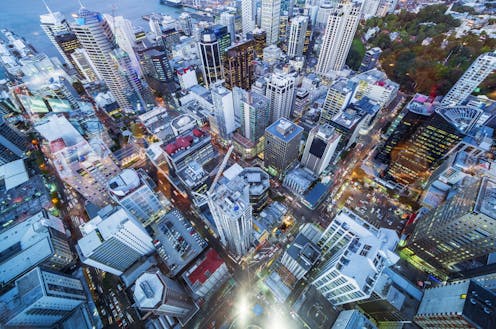As New Zealand CBDs evolve post-pandemic, repurposing old or empty spaces should be on the drawing board
- Written by Jose Antonio Lara-Hernandez, Senior Researcher in Architecture, Auckland University of Technology

The COVID-19 pandemic and the hybrid work patterns it fostered have changed the way we think about office space, and central business districts in general. While fears of urban centre “ghost towns” may have been premature, many cities around the world still face dilemmas over how best to adapt.
New Zealand is feeling this pressure too. Office vacancy rates, while dropping slightly, have remained above 12%. At the same time, there is demand for high-quality, modern spaces that fit new work and collaboration models.
This isn’t an entirely new phenomenon. Throughout history, cities and buildings have been designed with specific functions in mind. As environmental and social needs change, however, these designs struggle to meet contemporary demands.
So, what can be done with the empty buildings and unleased floors scattered through cities everywhere? In our new book, Architectural Exaptation: When Function Follows Form, we examine the process by which existing structures or features are re-imagined and re-utilised.
In architecture, the concept of “exaptation” refers to this adapting of buildings and structures for new uses. It is becoming increasingly relevant as a transformative response to sustainable and resilient urban development.
The benefits of adapting
Exaptation in architecture requires us to view built environments not just as physical spaces, but as complex living systems that can adapt and transform.
Reusing and repurposing existing structures also helps reduce waste, CO₂ emissions and energy use, supporting more sustainable urban growth. At the same time, by reusing rather than rebuilding, the historical and cultural fabric of cities is preserved, as well as their inhabitants’ sense of identity.
A famous example is Venice, which has continuously adapted its historic structures to meet modern needs, while maintaining their unique character.
Sometimes seen as a static relic of the past, Venice is in fact a dynamic example of how urban spaces can evolve. The city’s ability to repurpose spaces and structures – turning palazzos into museums or residential buildings into boutique hotels – demonstrates architectural exaptation in practice.
The Highline in New York provides another good example. Rather than demolish an old elevated railway, it was repurposed as a pedestrian walkway, becoming a now iconic public space.
The social life of cities
The notion and application of architectural exaptation also has profound implications for the way we approach urban planning and development. In particular, it challenges the linear thinking and conventional growth models behind building new structures.





